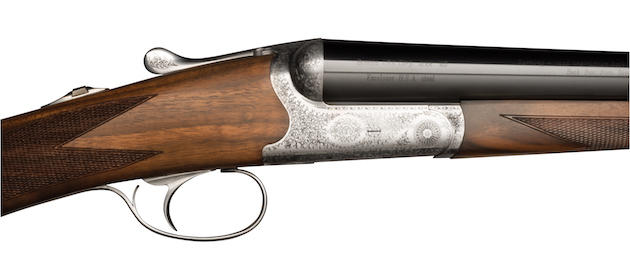From Robert Matthews’ shotgun column in the July/August 2015 issue of Sporting Classics.
Beretta, the famed Italian gunmaker, requires no introduction to the readers of this column. Beretta bills itself as the oldest gunmaking company in the world, and may well be, since they’ve been building guns of all kinds since the 1500s. They’ve made pistols, hunting rifles and shotguns, military guns, and I guess just about anything relating to guns that you could imagine. All of their stuff has been good. In fact, I’ve never heard any criticism about the quality of any gun made by Beretta.
In previous columns I’ve often expressed my high regard for their semiauto and over-and-under shotguns. The company also makes absolutely exquisite best-quality over-and-unders and side-by-sides, despite the fact that their bread-and-butter trade has always been “consumer grade” guns. That’s my own term for good-quality guns that are affordable for a person of average means. Notice that the word “cheap” hasn’t reared its head anywhere in this discussion.
In all the time that I’ve used Beretta guns, though, I’ve never really been attracted to their consumer grade side-by-sides. Indeed, I’ve always thought it odd that Beretta never chose to compete in that market. None of this is meant to denigrate their older side-by-sides, because, like I said, I don’t think I’ve ever even heard a single criticism of their field grade side-bys.
If I seem to tread lightly here, it’s because I want to praise their new side-by-side but without criticizing their previous efforts. That wouldn’t be fair. Sort of a catch 22, damned if you do, damned if you don’t kind of predicament. None of their older field guns were bad, mind you. It’s just that none of them “moved me” in the way that a side-by-side should.
Which brings us around to the little Beretta double that I’m shooting. Called the 486 Parallelo, it’s a 20-bore weighing only six pounds, 3 ounces with 28-inch barrels. It’s balanced perfectly on the leading edge of the hinge pin. The lockwork is carried on the trigger plate. It features a single selective trigger and leaf springs for a cleaner let-off. Mine has a splinter forend and a straight English grip. The gun is constructed using a new barrel-joining system that does away with the unflattering barrel-ring of their previous efforts.

Rather than giving one of their older models a facelift, Beretta introduced the 486 Parallelo with a redesigned action, springs, and trigger group. It’s available in 12 and 20 gauge.
The gun has a sleek, voluptuous, round-action body that’s as dainty as a wee lass. Trim and nimble, it moves me in a way that Beretta’s previous side-by-sides did not.
For as long as I can remember, I’ve been a fan of round-action trigger-plate guns, especially those typified by the MacNaughton, Dickson, and McKay Brown clan of Scottish guns. Absolutely nothing else carries as well in the hand or over the arm. Because the innards are attached to the trigger plate rather than to the receiver body like an Anson and Deeley boxlock, or to the locks of a sidelock gun, the action can be rounded to a degree that others can’t. If done well, this creates a gun that feels almost organic, that carries effortlessly and swings as naturally as pointing your finger. The problem with them is that if you can find one, it will either be ancient or expensive—or both.
All of the above praise applies to the 486 Parallelo. Needless to say, since it’s a Beretta, it functions perfectly, and I would be absolutely amazed if it proves to be anything less than brutally durable. It carries like a dream, and flies to the shoulder as quickly as an evil thought comes to mind. Because it’s well-balanced, it tracks a crossing target with an ease that belies its quickness.
The $5,400 price tag certainly doesn’t qualify it as inexpensive, but it’s not completely out of reach, either. I guess it depends on how much you value your shotgun and what else you might want to sacrifice.
Not surprisingly, there are things about the gun that I would do differently. As a first-rate picker of nits, and an opinionated old goat as well, it’s uncommon for me to find a gun that completely satisfies me. I could easily make the same observation about any number of best-quality doubles with prices well north of $100,000. And even some of them don’t catch my fancy the way this Beretta does.

The 486 Parallelo has new leaf springs in the action for faster and more precise firing-pin engagement. Its cold-hammer forged OptimaChoke barrels can handle every type of shell.
I guess my quibbles fall into the “vanilla vs. chocolate” category, and you might well disagree, but I still would make some changes that would probably find favor with a large portion of the American shotgun market.
Specifically, I’m not terribly fond of the “silver” finish or the laser-generated engraving. If I had my druthers, I’d probably go with something a little more subdued and more in keeping with the gun’s Scottish soul. The same goes for replacing the single trigger with a pair of nice, crisp pulls, and giving the wrist a little trimmer contour.
The interesting thing about the 486 is that Beretta got all of the hard parts of the design very, very right. The heart of this gun is stunning. With a few custom touches, it could go from good to fabulous in about 2.5 seconds, and set a benchmark for others in this part of the market to shoot for. I think I’ll talk to the folks at Beretta to see what we can arrange. Stay tuned, we might just be watching the evolution of a classic.

